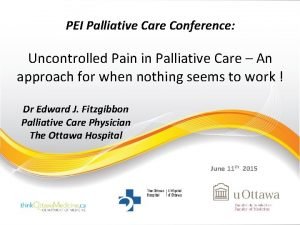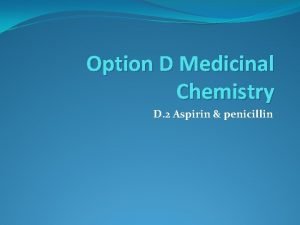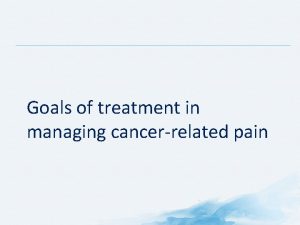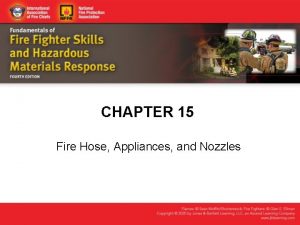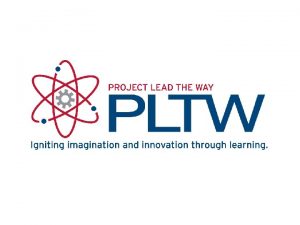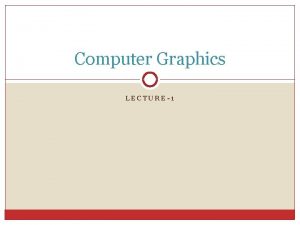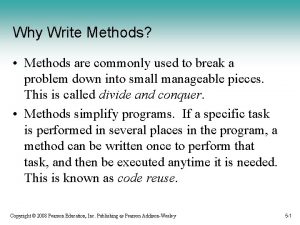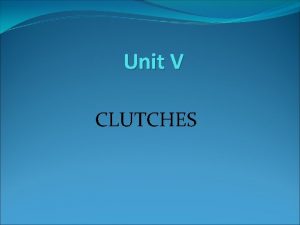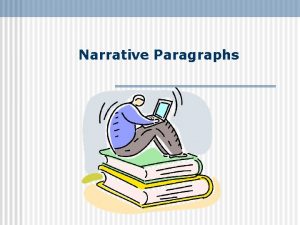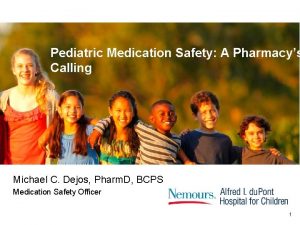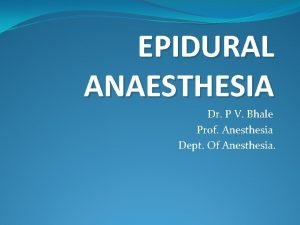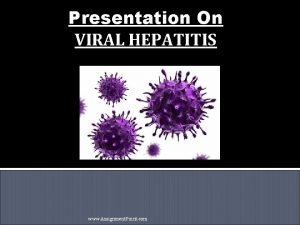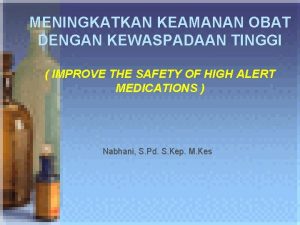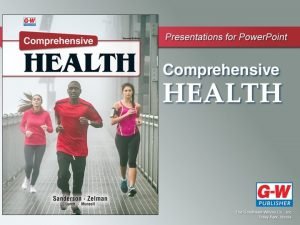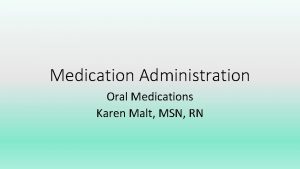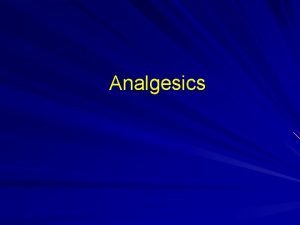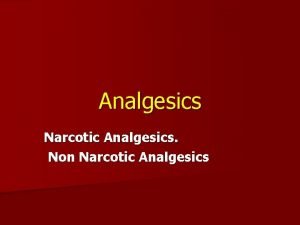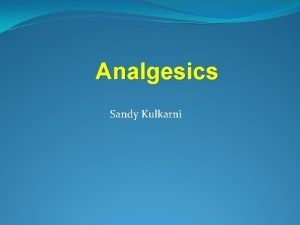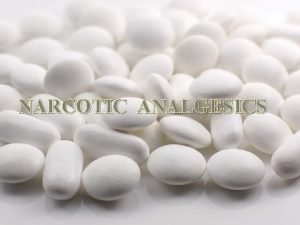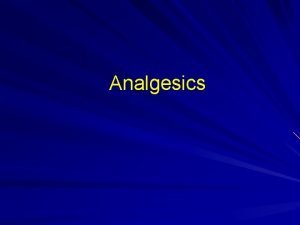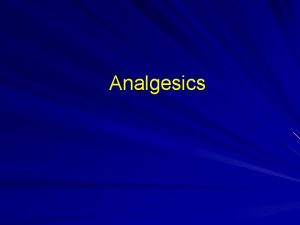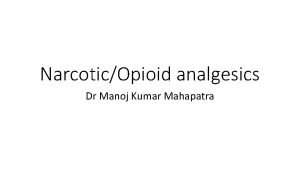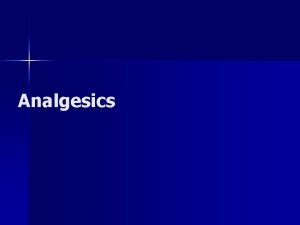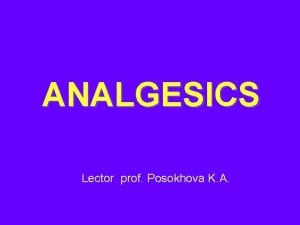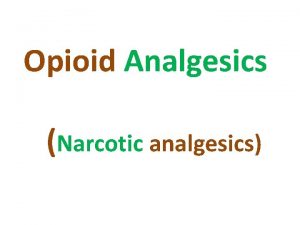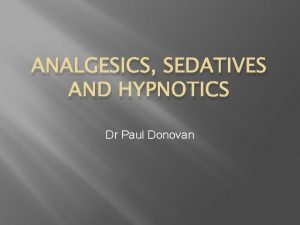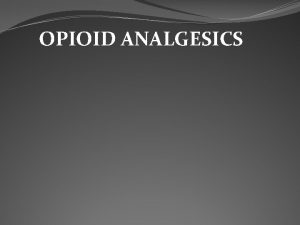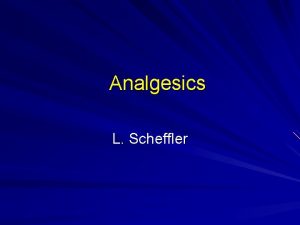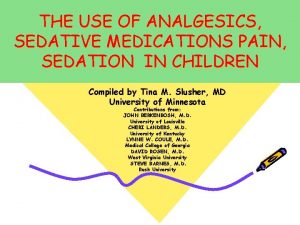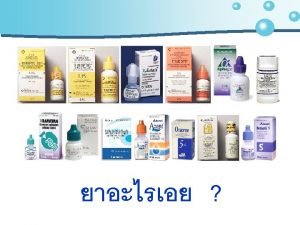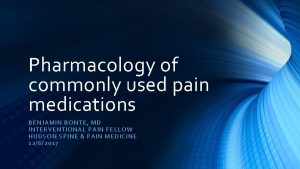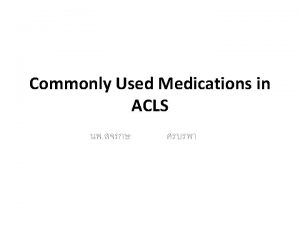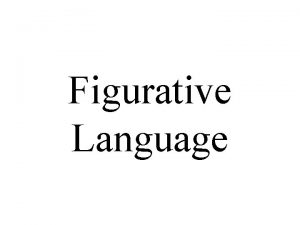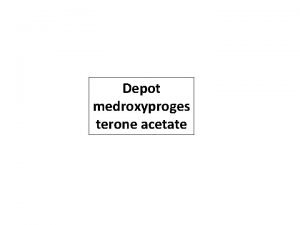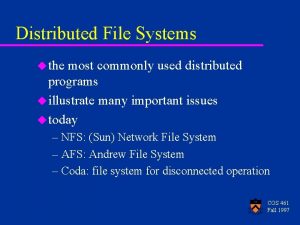Use of Analgesics Most commonly used medications in
























- Slides: 24

Use of Analgesics • Most commonly used medications in the US by survey data – #1: acetaminophen – #2: ibuprofen – #3: aspirin – 50% of users on for cardiovascular prophylaxis • Among most frequently prescribed meds to those over 65 • OTC analgesic use underreported to healthcare providers and 10 -40% of those prescribed NSAIDs concomitantly use OTC NSAIDs Kaufman, JAMA 2002; 287: 337 -344 Hensrud, Mayo Clin Proc 1999; 74: 443 -447 Eliason, J Am Board FP 1996; 9: 249 -253

Use of Analgesics • Each year in the US: – Over 30 billion OTC NSAID tablets sold (~$2 billion) – Over 70 million NSAID prescriptions written – NSAIDs have been potentially implicated in ~16, 500 deaths and ~100, 000 hospitalizations for adverse events; most are due to GI bleeds or renal impairment – These admits cost the healthcare system ~$2 billion. • Treatment of NSAID-related gastrointestinal side effects accounts for one third of the cost of arthritis therapy • Even though advanced age is well-known factor for adverse GI and renal events, over half of patients over 65 have been prescribed NSAIDs. Wolfe, NEJM 1999; 340: 1888 -1899 Curhan, Arch Intern Med 2002; 162: 2204 -2208 Tamblyn, Ann Intern Med 1997; 127: 429 -438

Possible Adverse Interactions between NSAIDs and ASA: Physician’s Health Study • Use of non-aspirin NSAIDs in conjunction with aspirin for primary prophylaxis may increase the risk of first MI – 22, 000 male physicians on aspirin 325 mg QOD or placebo – Aspirin use was associated with a 44% relative risk reduction of first MI – Concomitant NSAID use for 60 days/yr associated with increased risk of first MI (RR 2. 86; 95% CI 1. 25 -6. 56) Kurth, Circulation 2003; 108: 1191 -1195

Possible Adverse Interactions between NSAIDs and ASA • Use of NSAIDS in conjunction with ASA in patients after 1 st CV admission (angina, MI, CVA, TIA, PVD) – 7, 107 patients – Administration of ibuprofen with aspirin was associated with an increased risk of all-cause mortality (adjusted HR 1. 93, 95% CI 1. 30 -2. 87, p=0. 001) and CV mortality (1. 73, 1. 05 -2. 84, p=0. 031) compared to administration of ASA alone – Similar risks were found among patients in ASA alone, ASA plus diclofenac, and ASA plus other (non. Ibuprofen) NSAIDS. Lancet 2003; 361: 573 -4

Platelets in Hemostasis • Vascular injury • Platelet adhesion – Binding to exposed v. WF/collagen • Platelet activation – – ADP, 5 HT, PF 4, etc are released Signals cause COX conversion of arachidonic acid to thromboxane in platelets • Platelet aggregation – – Mediated by thromboxane Dense network of plateletfibrinogen bridges form occlusive thrombus Braunwald, Heart Disease 2001

Antiplatelet Action of Aspirin irreversibly inactivates COX, inhibiting thromboxane production. Braunwald, Heart Disease 2001

The Balance of COX-1 and COX-2 • COX-1 is expressed constituitively in many tissues. – In the GI tract, COX-1 results in cytoprotective prostacyclin production – In platelets, COX-1 activation results in Thromboxane Synthesis • Platelet aggregation • Vasoconstriction • Smooth muscle proliferation • COX-2 is induced at sites of inflammation. – In the endothelium, COX-2 production of prostacyclin inhibits the actions of thromboxane • Inhibits platelet aggregation • Vasodilator

The Balance of COX-1 and COX-2: A Simplified Model • In vivo, there is a balance of COX-1 and COX-2 activity resulting in maintenance of vascular hemostasis. • Non-selective NSAIDS act by suppressing both COX-1 and COX-2 activity, with generally no net effect on hemostasis. • Selective COX-2 Inhibitors, by inhibiting COX-2 and allowing COX-1 activation (COX-1 is unopposed), have the potential for potentiating thrombosis and vasoconstriction. – ? Increased CV risks in retrospective non-randomized analyses

Selective COX-2 Inhibitors and Cardiovascular Outcomes VIGOR: The Vioxx Gastrointestinal Outcomes Research Study • Rofecoxib (Vioxx) (50 mg qd) vs. naproxen (500 mg bid) • 8, 076 patients with rheumatoid arthritis – – – – Excluded patients on ASA or with CV events requiring ASA 1 o endpoint: GI events reduced in rofecoxib group Higher CV event rates among patients treated with rofecoxib MI rate of 0. 4% vs. 0. 1% (95% CI 0. 1% to 0. 6% for rofecoxib) 38% of events occurred in the 3. 9% of patients who qualified as aspirin candidates (for secondary prophylaxis) Among pts without indication for ASA prophylaxis, MI rates did not differ between rofecoxib and naproxen ? Untoward effect of rofecoxib among pts not treated with ASA or beneficial effect of naproxen NEJM 2000; 343: 1520 -8

Selective COX-2 Inhibitors and Cardiovascular Outcomes CLASS: Celecoxib Long-term Arthritis Safety Study • Celecoxib (400 mg bid) vs. ibuprofen (800 mg tid) or diclofenac (75 mg bid). Naproxen not evaluated. • 8, 059 patients, majority with osteoarthritis – – Patients were permitted to take ASA (22%) unlike VIGOR No difference in MI rates among groups Similar rates of CV and cerebrovascular events No differences in non-ASA subgroup (underpowered though) – Reduced bleeding rates in celecoxib arm vs. NSAID alone (6. 0% vs 3. 1%) – The two comparator arms (diclofenac and ibuprofen) have relatively weak antiplatelet effects JAMA 2000; 284: 1247 -55

Pooled Analyses of COX-2 Selective Agents • Mukherjee et al (JAMA 2001) – Compared MI rates from RCT’s (including VIGOR and CLASS) with 23, 407 patients in placebo arms of primary prevention trials of ASA, and found higher MI rates among patients taking refecoxib and celecoxib – Annualized MI rates: 0. 52% for placebo; rofecoxib 0. 74% (p=0. 04); celecoxib 0. 80% (p=0. 02) – ? confounded by comparisons of different groups of patients: txd pts with inflammation compared to placebo pts from primary prevention *Reicin et al, AJC 2002 White et al, AJC 2002 Mamdani et al, Arch Int Med 2003

Pooled Analyses of COX-2 Selective Agents • Konstam et al (Circulation 2001) – 28, 000 patients from rofecoxib clinical trials – No difference in CV events between rofecoxib vs. NSAIDS other than naproxen – Higher risk of thrombotic events with rofecoxib vs. naproxen (RR 1. 69 with 95% CI 1. 07 -2. 69). • Other studies have demonstrated no differences between COX-2 selective agents vs. non-Naproxen NSAIDS* *Reicin et al, AJC 2002 White et al, AJC 2002 Mamdani et al, Arch Int Med 2003

NSAIDS and COX-1 Suppression • Aspirin: Irreversibly acetylates cyclooxygenase in platelets • Inhibits COX-1 166 times more than COX-2 • 95% suppression of COX-1 activity is necessary to inhibit Thromboxane-dependent platelet aggregation – This degree of COX-1 suppression is achieved with low -dose ASA (92% inhibition of aggregation with 81 mg) – Other NSAIDS produce variable reversible COX-1 suppression with time-dependency (relative to the dosing cycle), which may explain beneficial effects of aspirin relative to these agents.

Aspirin • Secondary prevention – >20% reduction in vascular events • Primary prevention: consistent reduction in CV events may be offset by an increase in hemorrhagic stroke and other bleeding events (especially in low-risk patients) From 3 rd US Preventive Task Force; Ann Int Med 2002; 136(2): 157 -60

Naproxen • Naproxen: non-selective NSAID with greater COX-1 activity* – 95% inhibition of thromboxane synthesis – 88% inhibition of platelet aggregation • Observational case-control studies have suggested possible cardioprotective effect not seen with other nonselective NSAIDS, and benefits in comparison to other agents (e. g. ibuprofen). ** *J Clin Pharm 2000; 40: 1109 -20 **Lancet 2002; 359: 118 -23 Arch Int Med 2002, Vol 162

Antagonism of COX-1 Inhibition by Aspirin Prior occupancy of the catalytic site by ibuprofen may prevent aspirin from gaining access to its target serine. Catella-Lawson, NEJM 2001; 345: 1809 -1817

Effects of NSAIDs on Inhibition of COX-1 Activity by Aspirin • Crossover Study (Single Doses of Each Medication) – Aspirin 2 hours prior to ibuprofen, then reversed – Aspirin 2 hours prior to acetaminophen, then reversed – Aspirin 2 hours prior to rofecoxib, then reversed • Parallel-Group Study with Multiple Daily Doses of NSAIDs – Aspirin, then ibuprofen tid starting 2 hours later – Aspirin, then diclofenac bid starting 2 hours later Catella-Lawson, NEJM 2001; 345: 1809 -1817

Effects of NSAIDs on Inhibition of COX-1 Activity by Aspirin Catella-Lawson, NEJM 2001; 345: 1809 -1817

Effects of NSAIDs on Inhibition of COX-1 Activity by Aspirin (Single Dose Crossover) Mean inhibition of cyclooxygenase-1 activity as assessed by measurement of serum thromboxane B 2 and inhibition of platelet aggregation after six days of therapy. Catella-Lawson, NEJM 2001; 345: 1809 -1817

Effects of NSAIDs on Inhibition of COX-1 Activity by Aspirin (Single Dose Crossover) • Despite initial inhibition of COX-1 activity by Ibuprofen, Ibuprofen prior to ASA inhibited anti-COX-1 effects of ASA – Not seen when ASA was administered prior to ibuprofen • Acetaminophen had no significant intrinsic or antagonistic effects on anti-COX-1 activity • Similar results were seen with rofecoxib (COX-2 selective agent) Catella-Lawson, NEJM 2001; 345: 1809 -1817

Effects of NSAIDs on Inhibition of COX-2 • No intrinsic anti-COX 2 effects of ASA were seen – All effects on Prostaglandin production were seen after administration of the other agents – Consistent with the known half-lives of these agents. • Ibuprofen: up to 80% inhibition that was transient • Acetaminophen: up to 50% inhibition that was transient • Rofecoxib: > 80% inhibition that was sustained Catella-Lawson, NEJM 2001; 345: 1809 -1817

Effects of NSAIDs on Inhibition of COX-1 by Aspirin (Multiple Doses) Mean inhibition of cyclooxygenase-1 activity as assessed by measurement of serum thromboxane B 2 and inhibition of platelet aggregation after six days of therapy. Catella-Lawson, NEJM 2001; 345: 1809 -1817

Effects of NSAIDs on Inhibition of COX-1 by Aspirin (Multiple Doses) • Multiple Daily Doses of ibuprofen antagonized the anti-COX-1 effects of ASA – Allowed recovery of thromboxane synthesis and platelet aggregation – These findings persisted even though ASA was administered 2 hours prior to the daily dose of ibuprofen • This effect was not seen with diclofenac Catella-Lawson, NEJM 2001; 345: 1809 -1817

Conclusions • Commonly used OTC doses of NSAIDs may inhibit the antiplatelet effects of aspirin via competitive binding to COX -1. • Patients who use aspirin for cardiovascular prophylaxis and self medicate with the OTC analgesic ibuprophen may risk reducing aspirin’s antiplatelet effect. • Acetaminophen and naproxen do not appear to share this property and may be taken with aspirin without affecting its antiplatelet effects.
 Mechanism of action of opioid analgesics
Mechanism of action of opioid analgesics Classification of analgesic
Classification of analgesic Liquid gabapentin for cats dosage chart
Liquid gabapentin for cats dosage chart Fire hose appliances
Fire hose appliances Drinking black coffee drivers ed
Drinking black coffee drivers ed Most commonly used system
Most commonly used system And shades
And shades Types of optical storage
Types of optical storage Full section views
Full section views Constrains two faces, edges, points, or axes together.
Constrains two faces, edges, points, or axes together. Computer graphics models are now commonly used for making
Computer graphics models are now commonly used for making Methods are commonly used to:
Methods are commonly used to: How is volume achieved with thermal curls
How is volume achieved with thermal curls The commonly used angle between leather or asbestos
The commonly used angle between leather or asbestos Where does the radial line development commonly used
Where does the radial line development commonly used Component of a narrative paragraph
Component of a narrative paragraph A pneumatic drill is commonly used
A pneumatic drill is commonly used Common pediatric medications
Common pediatric medications Epidural anesthesia drugs
Epidural anesthesia drugs Hepatitis d
Hepatitis d List of high-alert medications jci
List of high-alert medications jci Chapter 11 medications and drugs
Chapter 11 medications and drugs Mock code steps
Mock code steps 5 rights of medication
5 rights of medication Chapter 30 administering medications
Chapter 30 administering medications
